- The Problem of Violence Against Healthcare Staff
- Violence in Healthcare: Statistics and Risks
- Nursing Associations and Problem Recognition
- HR 5223 and Theoretical Models
- HR 5223: Proposed Changes and Benefits
- HR 5223 and Benefits for Stakeholders
- Potential Barriers to the Passage of HR 5223
- How to Overcome the Potential Barriers
- References
The Problem of Violence Against Healthcare Staff
- Violence against healthcare staff is underreported in the majority of organizations;
- There are four types of workplace violence based on the associations between perpetrators and victims (Phillips, 2016);
- Nowadays, risk prevention guidelines provided by OSHA are not mandatory (Phillips, 2016).
Today, nurses and other hospital staff members all over the world are subject to workplace violence. The first problem with violence in healthcare is its being underreported or even ignored. As is stated by the Joint Commission, even the safest healthcare organizations started experiencing an increase in workplace crime rates recently (Phillips, 2016).
There are four forms of workplace violence that help to differentiate between violent acts committed by non-patients with intent, patients or clients, current and former staff members, and people in personal relationships with healthcare providers (Phillips, 2016). The cases with patients acting as offenders are overrepresented when it comes to statistics, but unfortunately, there are no mandatory nationwide guidelines for the reduction of risks.

Violence in Healthcare: Statistics and Risks
- Three-fourths of all physical attacks against healthcare professionals are committed by patients;
- In the United States, more than 70% of all workplace violence cases occur in healthcare settings (Phillips, 2016);
- The highest risks exist for ED nurses and psychiatric staff (Phillips, 2016);
- Known “triggers” of workplace violence: long waiting times, low nurse-to-patient ratios, service quality, patients’ social/economic position (Ridenour et al., 2015).
Continuing on the scale of the problem, it is pivotal to say that healthcare specialists present the group the most vulnerable to workplace violence in the United States. The main source of risk, as is clear from modern studies, is an inadequate behavior of healthcare clients who may have psychiatric issues or be mentally healthy. The risks of being assaulted by patients are extremely high for specialists working with emergency and psychiatric clients; for instance, up to 100% of emergency department nurses experience violence at least once (Phillips, 2016). Also, there are hypotheses that link violence to external factors and problems with healthcare quality.
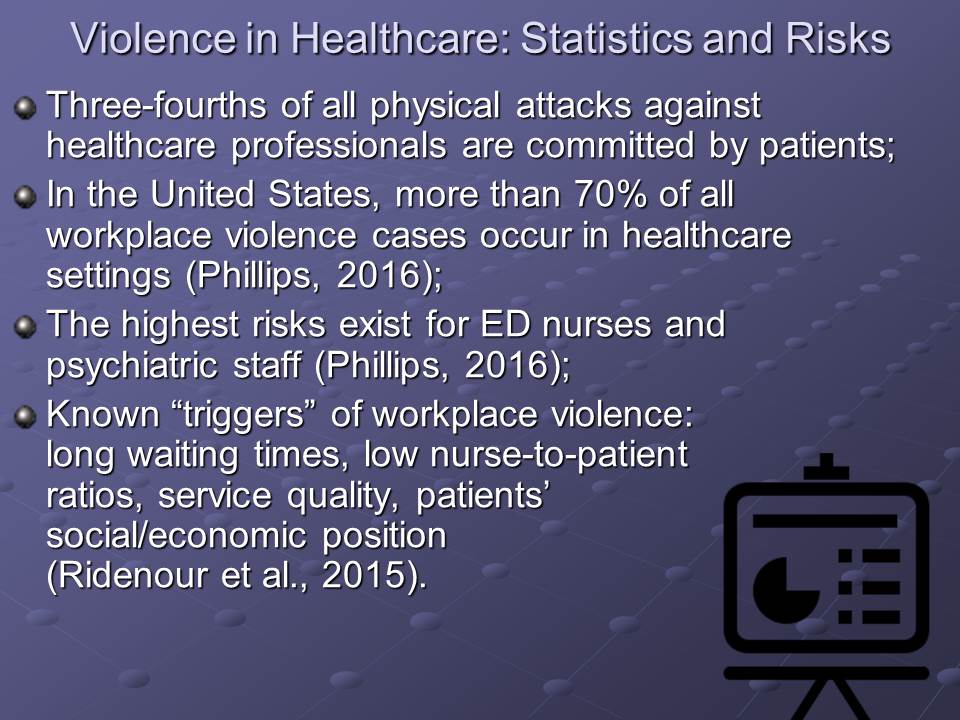
Nursing Associations and Problem Recognition
- In some states, OSHA guidelines are applied only to specific hospital departments (ANA, 2017);
- Incident reporting requirements are not unified (ANA, 2017);
- Assaulting emergency nurses should be considered a felony in all states (ENA, n.d.).
The need to support the passage of HR 5223 requiring the introduction of national standards for violence prevention is recognized by professional nursing associations such as ANA. In one of its materials on workplace violence, the organization highlights the heterogeneity in the approaches to violence prevention. For instance, in nine states, prevention programs are required to be implemented only at psychiatric and emergency departments, whereas the requirements for incident reporting significantly vary across the states (ANA, 2017). The problem is also widely discussed by the Emergency Nurses Association aimed at protecting the interests of ED nurses who have the highest risks of being assaulted at work.
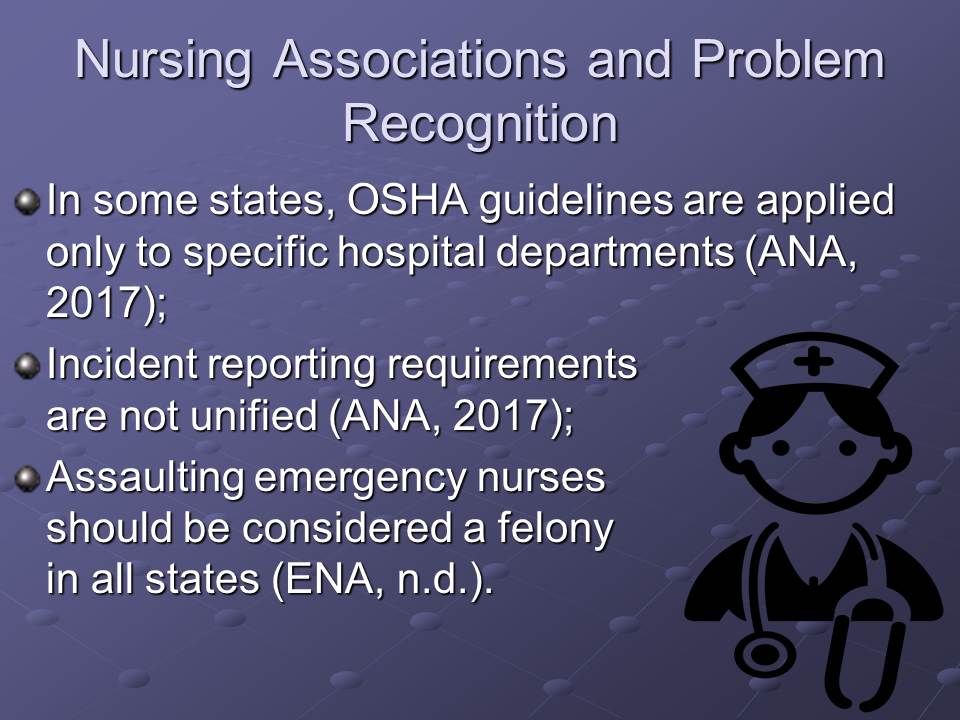
HR 5223 and Theoretical Models
- Healthcare specialists who face the risks of violence present a large interest group (Lowery et al., 2015);
- Policy-making can be impacted with the help of united efforts;
- Success is predicted by social activity and strong leadership.
The passage of HR 5223 remains a highly sensitive task, and to support the bill, it can be necessary to utilize a proper theoretical model. In case of violence against healthcare workers, there is a great number of stakeholders who have common problems but may be deprived of significant political power as individuals. With that in mind, the interest group model of policy-making can be relevant to the situation (Lowery et al., 2015). To use it, the key stakeholders should unite to change the existing balance of interests. Importantly, internal conflicts between stakeholders based on the degree of vulnerability should be eliminated.
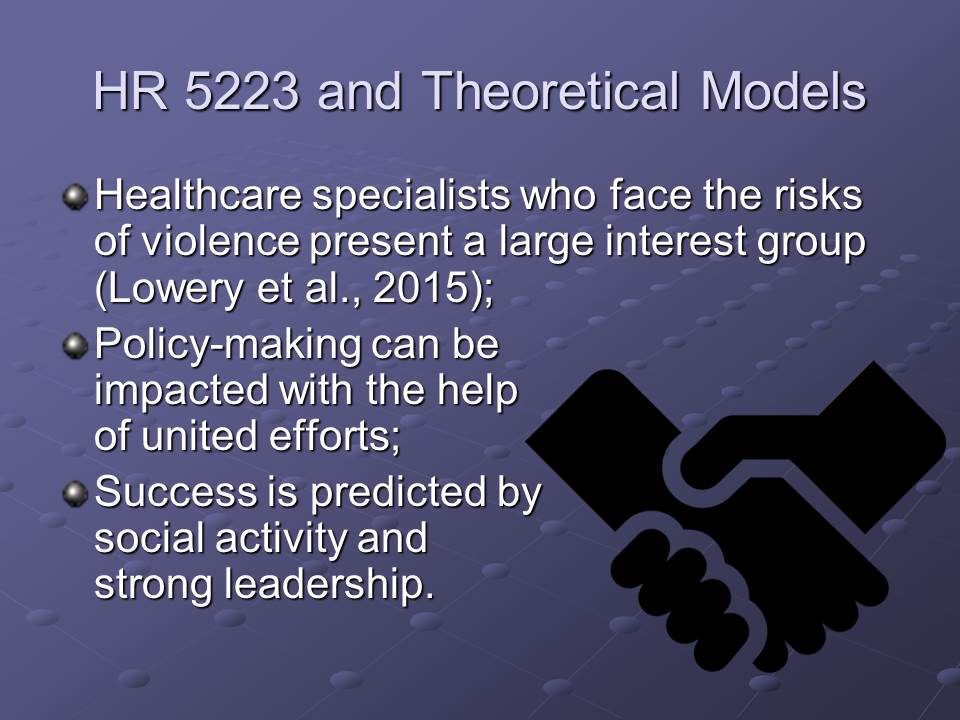
HR 5223: Proposed Changes and Benefits
- Mandated risk identification procedures for employers (weapons owned by patients, substance abuse in clients, etc.);
- The presence of security personnel;
- Collaboration with agencies responsible for law enforcement (Health Care Workplace Violence Prevention Act, 2018).
HR 5223 introduced by Khanna and his supporters raises the problem of workplace violence and requires the Department of Labor to design and implement national violence prevention standards for employers in healthcare. The aspects of the problem paid focused attention to include the absence of mandatory risk assessment procedures aimed at the identification of potential offenders. More than that, according to the project, it is necessary to develop business relationships between healthcare facilities and law enforcement agencies to ensure timely responses to the cases of violence against healthcare staff.
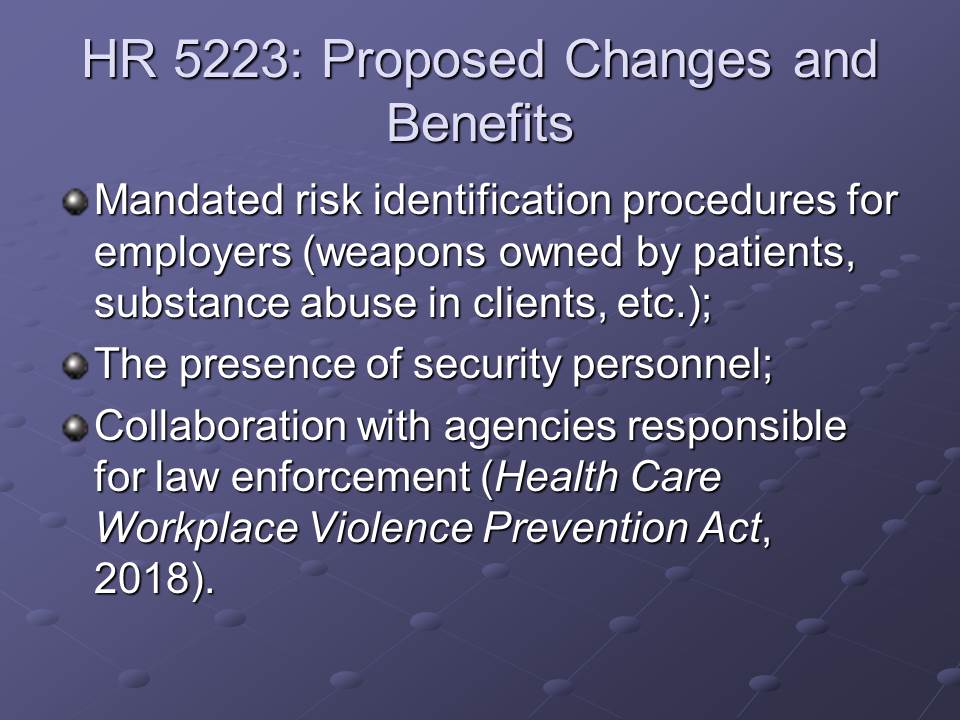
HR 5223 and Benefits for Stakeholders
- Healthcare employers – increased job satisfaction rates, the effectiveness of employee retention strategies;
- Healthcare staff – safety, improved psychological well-being, employee productivity;
- Clients – care quality and safety.
The passage of the bill being discussed will be beneficial to three main categories of stakeholders such as healthcare employers, healthcare staff, and clients. When it comes to employers, they will have to implement a range of new rules, which may require a large amount of resources. However, having increased workplace safety, they will positively impact employee satisfaction rates and, therefore, prevent many qualified specialists from quitting their jobs. The benefits for healthcare specialists will be the most obvious due to the reduced risks’ impact on their psychological health and productivity at work. Finally, in reference to patients, they can benefit from the law because the presence of procedures for the identification of potentially dangerous clients will improve their safety as well. Moreover, nurses’ job satisfaction will positively impact the quality of patient service.

Potential Barriers to the Passage of HR 5223
- Potential conflicts between stakeholders during the stage of plan development;
- There is a threat of manipulations with definitions aimed at achieving healthcare providers’ personal goals.
The initiative in the bill is supported by many organizations, but when it comes to the practical side of its implementation, there can be potential issues that need to be clarified and resolved. First, it is supposed that plans for the prevention of violence will be created individually with the participation of doctors and nursing staff. However, the extent to which the opinion of different stakeholder groups will guide decision-making is not discussed.
Next, unlike the previous bills devoted to the topic, HR 5223 includes threats of violence into the definition of violence. The threat of violence is defined as any behavior or verbal statement that makes people fear for their safety (Health Care Workplace Violence Prevention Act, 2018). Given that the sensation of fear is subjective, there will be an opportunity for healthcare providers to overuse the requirements to avoid providing services to some patients. For some congressional voters, these problems can be important.
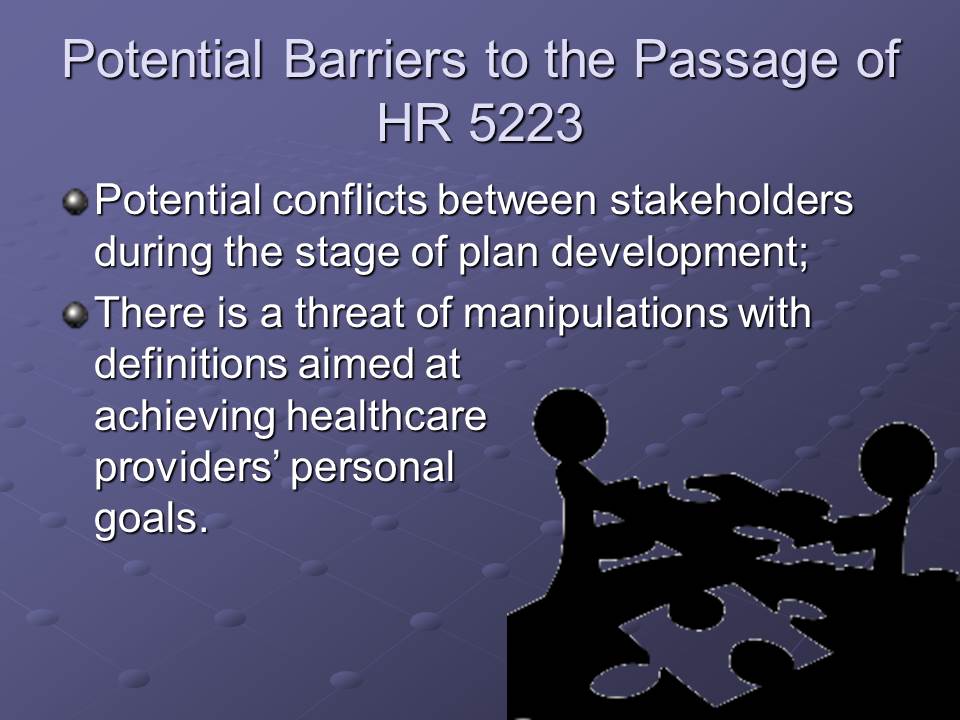
How to Overcome the Potential Barriers
- Ensure that the text contains no logical flaws;
- Present the discussion of conflict resolution procedures to be used by teams;
- Ensure that there are no opportunities to make wrongful accusations and violate patients’ rights.
To overcome the identified barriers, it can be pivotal to ensure that the proposed bill does not contain self-contradictory statements or requirements that can be understood in a variety of ways. In order to address the first potential issue, some procedures for conflict resolution in interdisciplinary teams working on prevention plans may need to be introduced. Also, clarifying the criteria to identify some behaviors as the threats of violence would be critical to success.
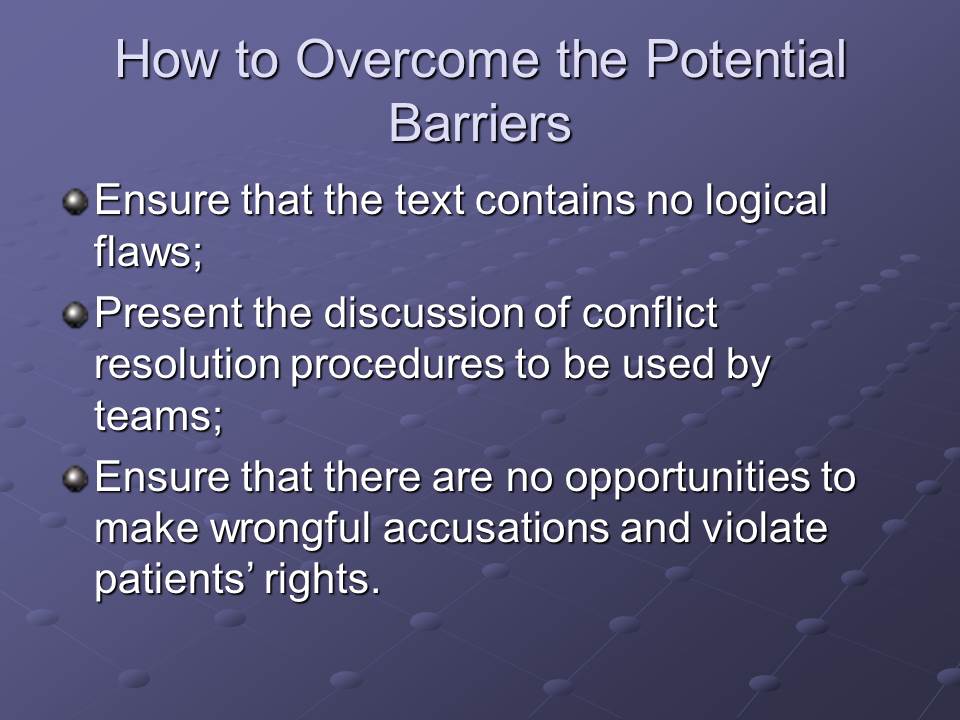
References
ANA. (2017). Workplace violence. Web.
ENA. (n.d.). Workplace violence. Web.
Health Care Workplace Violence Prevention Act, H.R. 5223, 115th Cong. (2018).
Lowery, D., Baumgartner, F. R., Berkhout, J., Berry, J. M., Halpin, D., Hojnacki, M., … Schlozman, K. L. (2015). Images of an unbiased interest system. Journal of European Public Policy, 22(8), 1212-1231.
Phillips, J. P. (2016). Workplace violence against health care workers in the United States. New England Journal of Medicine, 374(17), 1661-1669.
Ridenour, M., Lanza, M., Hendricks, S., Hartley, D., Rierdan, J., Zeiss, R., & Amandus, H. (2015). Incidence and risk factors of workplace violence on psychiatric staff. Work, 51(1), 19-28.